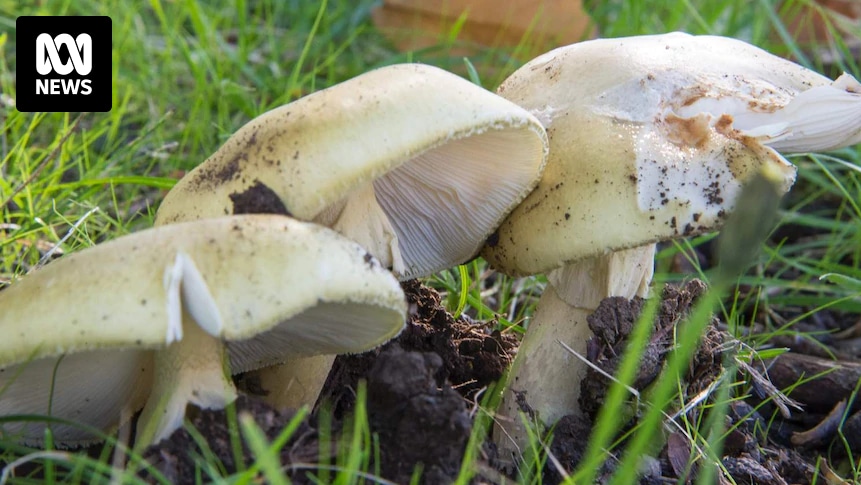Foraging tour operators say rising insurance costs are making their operations more difficult, but those involved in the insurance industry say it is unlikely to be connected with Erin Patterson’s triple-murder trial.
This week, Patterson was found guilty of killing three relatives and attempting to kill another by feeding them beef Wellington made with death cap mushrooms.
Feresh Pizarro moved to a farm near Robe in South Australia’s south-east three years ago to start her business, South Spore.
One death cap mushroom can kill a healthy adult when ingested. (ABC News: Penny Travers)
She said had she cancelled her usual autumn and winter tours because of rising insurance costs, and she knew two other businesses similarly affected.
Ms Pizarro said she believed the increase in premiums was connected with Patterson’s trial.
“The insurance went up by ridiculous amounts, so I actually can’t make it viable,” Ms Pizarro said.
Listen to the latest Mushroom Case Daily episodes
“It’s a pity, this is what I love. I want people to know and understand the fungi queendom — it’s huge.
“It’s not just about edibles, it’s about the role they play.
“There are mushrooms that have been proven to eat plastic or completely clean oil spills and transform them into a beautiful little environment.”
Similarly, Natasha Vorogushin, who runs mushroom foraging tours in Morwell, Victoria, where Patterson was put on trial, said she had only been able to get general public liability insurance, not coverage specifically tailored for her work.
“I’ve contacted quite a few insurance companies and had trouble finding anyone who would insure me for that specific type of workshop,” Ms Vorogushin said.
Richard Ford, who runs tours in Mount Macedon, said his employer already had high insurance costs.
“She said if they put the insurance up she certainly wouldn’t be able to do it, no,” he said.
Feresh Pizarro holding a Cordyceps gunnii fungus. (Supplied: Feresh Pizarro)
Insurers question trial’s impact
An Insurance Council of Australia spokesperson said the organisation was not aware of concerns from members about mushrooms or mushroom risks.
They said it was not common for insurers to change their offerings just because of “perceived risk”.
University of NSW actuarial studies professor Michael Sherris agreed it was unlikely a single court case like Patterson’s would influence insurance costs.
He said insurance costs in general were rising, and so probably were premiums for tour companies.
Professor Sherris said commercial liability insurance sometimes had clauses excluding high-risk activities like skydiving, but exclusions for mushroom tours were unlikely.
“Normally, you don’t have a mushroom foraging exclusion clause,” he said.
In Australia, deadly dapperling mushrooms are only known to grow in SA. (Supplied: State Herbarium)
Adelaide Botanic Garden and State Herbarium senior mycologist Teresa Lebel said there had never been a fatality from death cap mushrooms in South Australia.
However, she said the state did have another species, called the deadly dapperling mushroom, that led to a person being badly poisoned in 2022.
“They were seriously ill for two to three months afterwards — very fortunate for them that we were able to ID it and get them into treatment quickly,” Dr Lebel told ABC Radio Adelaide.
Deadly dapperling mushrooms look similar to field mushrooms but have white gills underneath the head.
SA Health said recently that death cap mushrooms had been found at several locations in the Adelaide Hills.
Teresa Lebel says Erin Patterson’s trial has raised the profile of her specialty. (Facebook: Adelaide Botanic Garden)
More interest but misinformation
Dr Lebel said Patterson’s trial had led to more interest in fungi from the public, with an uptick in entries on the iNaturalist website, where people can report the location of plants and animals they find in the wild.
“It’s been sad but fantastic in some ways,” she said.
As well as running tours, Feresh Pizarro grows a wide range of mushrooms and converts them into various products. (Supplied: Feresh Pizarro)
However, Ms Pizarro said some people were commenting incorrectly on social media about which fungi were edible.
“That really scares me — but once you know the identification method, it shouldn’t be that hard,” she said.
“You just have to make sure that you’re 100 per cent every time — there’s no wiggle room.
“The same for any plant — if you don’t know what it is, you’re not going to eat it.”
